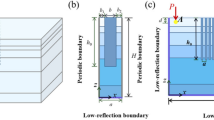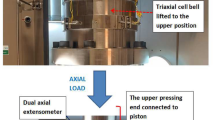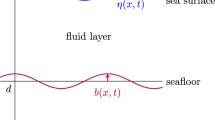Abstract
Due to the periodicity and rhythmicity of sedimentation, short-term cycles are commonly developed in sedimentary strata. Under the assumption of a long seismic wavelength, such strata can be regarded as a seismic single thin bed with vertical transversely isotropic (VTI) characteristics. A thin interbed can be formed by the stacking of a series of isotropic and VTI single thin beds. In seismic inversion, the interference of multiples and mode-converted waves generated within and between thin beds and transmission losses are ignored. These interferences are hardly addressed in seismic data processing due to being submerged in first arrivals. In this work, to thin interbeds of isotropic and VTI single thin beds, we propose second-order approximations of Kennett reflection coefficients for PP-, SP-, PS-, and SS-waves, which consider the internal and interlayer wave propagation effects. The numerical analyses show that the proposed approximations are of high accuracy when the P-wave impedance difference in the VTI single thin bed is from − 40 to 100% and of strong anisotropy. The proposed approximations can be used for the efficient and accurate simulation of the wavefields of media with thin interbedding, bringing great potential for the studies of the inversion methods for the internal property parameters of thin interbeds.












Similar content being viewed by others
Data availability
The data underlying this article will be shared on reasonable request to the corresponding author.
References
Backus GE (1962) Long-wave elastic anisotropy produced by horizontal layering. J Geophys Res 67(11):4427–4440
Carcione JM, Kosloff D, Behle A (1991) Long-wave anisotropy in stratified media: a numerical test. Geophysics 56(2):245–254
Castagna JP, Batzle ML, Eastwood RL (1985) Relationships between compressional-wave and shear-wave velocities in clastic silicate rocks. Geophysics 50(4):571–581
Christopher J, Roger Y (1993) Implications of thin layers for amplitude variation with offset (AVO) studies. Geophysics 58(8):1200–1204
Foster DJ, Lane FD, Zhao ZY (2017) A systematic approach for quantifying wave propagation in vertically inhomogeneous media. Geophys J Int 210(2):706–730
Gardner GHF, Gardner LW, Gregory AR (1974) Formation velocity and density—the diagnostic basics for stratigraphic traps. Geophysics 39(6):770–780
Graebner M (1992) Plane-wave reflection and transmission coefficients for a transversely isotropic solid. Geophysics 57(11):1512–1519
Imhof MG (2003) Scale dependence of reflection and transmission coefficients. Geophysics 68(1):322–336
Kennett BLN (1974) Reflections, rays, and reverberations. Bull Seismol Soc Am 64(6):1685–1696
Kennett BLN (1983) Seismic wave propagation in stratified media. Cambridge University Press, Cambridge
Kennett BLN, Kerry NJ (1979) Seismic waves in a stratified half space. Geophys J Int 57(3):557–583
Liu YB, Schmitt DR (2003) Amplitude and AVO responses of a single thin bed. Geophysics 68(4):1161–1168
Meissner R, Meixner E (1969) Deformation of seismic wavelets by thin layers and layered boundaries. Geophys Prospect 17(1):1–27
Pan W, Kristopher A (2013) AVO/AVF analysis of thin-bed in elastic media. In: 83rd Annual International Meeting, SEG, Expanded Abstracts, pp 373–377
Postma GW (1955) Wave propagation in a stratified medium. Geophysics 20(4):780–806
Rüger A (2002) Reflection coefficients and azimuthal AVO analysis in anisotropic media. Society of Exploration Geophysics, Houston
Schoenberg M, Protázio J (1992) “Zoeppritz” rationalized and generalized to anisotropy. J Seism Explor 1(2):125–144
Thomsen L (1986) Weak elastic anisotropy. Geophysics 51(10):1954
Treitel S, Robinson EA (1966) Seismic wave propagation in layered media in terms of communication theory. Geophysics 31(1):17–32
Wang Y, Yang C, Lu J (2018) Dilemma faced by elastic wave inversion in thinly layered media. Chin J Geophys 61(3):1118–1135
Werner U, Shapiro SA (1998) Intrinsic anisotropy and thin multilayering-two anisotropy effects combined. Geophys J Int 132(2):363–373
Yang Z, Lu J (2020) Second-order approximation of the seismic reflection coefficient in thin interbeds. Energies 13(6):1465
Yang C, Wang Y, Wang Y (2016) Reflection and transmission coefficients of a thin bed. Geophysics 81(5):N31–N39
Yuan SY, Wang SX, Ma M, Ji YZ, Deng L (2017) Sparse bayesian learning-based time-variant deconvolution. IEEE Trans Geosci Remote Sens 55(11):6182–6194
Funding
This work was supported the National Natural Science Foundation of China (U1839208) and the support of the Research and Development Funds of Sinopec (P21066-4).
Author information
Authors and Affiliations
Corresponding author
Ethics declarations
Conflict of interest
The authors have no competing interests to declare that are relevant to the content of this article.
Additional information
Edited by Prof. Sanyi Yuan (ASSOCIATE EDITOR) / Prof. Michał Malinowski (CO-EDITOR-IN-CHIEF).
Appendices
Appendix 1: Kennett equations and the second-order approximation for isotropic media
As shown in Fig. 13, for an isotropic layered model with m interfaces, Kennett (1983) proposed the equations of reflectivity method for calculating the total reflection coefficients at Interface n:
where \({\mathbf{R}}_{{\text{D}}}^{{{(}n{)}}}\) and \({\mathbf{T}}_{{\text{D}}}^{{{(}n{)}}}\) are the down-going single-interface reflection and transmission coefficient matrices at Interface n, \({\mathbf{R}}_{{\text{U}}}^{{{(}n{)}}}\) and \({\mathbf{T}}_{{\text{U}}}^{{{(}n{)}}}\) are the up-going coefficient matrices at Interface n, and I is the identity matrix.
The single-interface reflection and transmission coefficient matrices are:
where r and t are the reflection and transmission coefficients of isotropic media, respectively. \({\dot{\mathbf{R}}}_{{\text{D}}}^{(n - 1)}\) is obtained from the total reflection matrix \({\hat{\mathbf{R}}}_{{\text{D}}}^{(n - 1)}\) at Interface n − 1 by the phase shift to the bottom of Interface n:
where E is the phase-shift factor, and its expansion form is shown in Eq. (9).
Yang and Lu (2020) used Taylor’s expansion approach to expand the Kennett equation as:
Then, they gave the second-order approximations of isotropic thin interbeds:
Appendix 2: Graebner equations
Graebner (1992) derived the single-interface reflection and transmission coefficients of VTI layered media:
whose expansion form is:
where r and t are the reflection and transmission coefficients for a single interface of an VTI medium, respectively, and the superscripts D and U refer to the down-going and up-going waves, respectively.
The following expressions are the direction cosines of the polarization vectors:
with aij≡cij/ρ, where cij is the stiffness component, ρ is the density of the layer, qα and qβ are the vertical slowness of P- and S-waves, respectively; and p is the horizontal slowness. Subscripts 1 and 2 refer to the lower and upper layers, respectively.
Rights and permissions
About this article
Cite this article
Huang, P., Lu, J. & Wang, Y. Second-order approximate reflection coefficients of vertical transversely isotropic thin beds. Acta Geophys. 70, 1155–1169 (2022). https://doi.org/10.1007/s11600-022-00758-y
Received:
Accepted:
Published:
Issue Date:
DOI: https://doi.org/10.1007/s11600-022-00758-y





